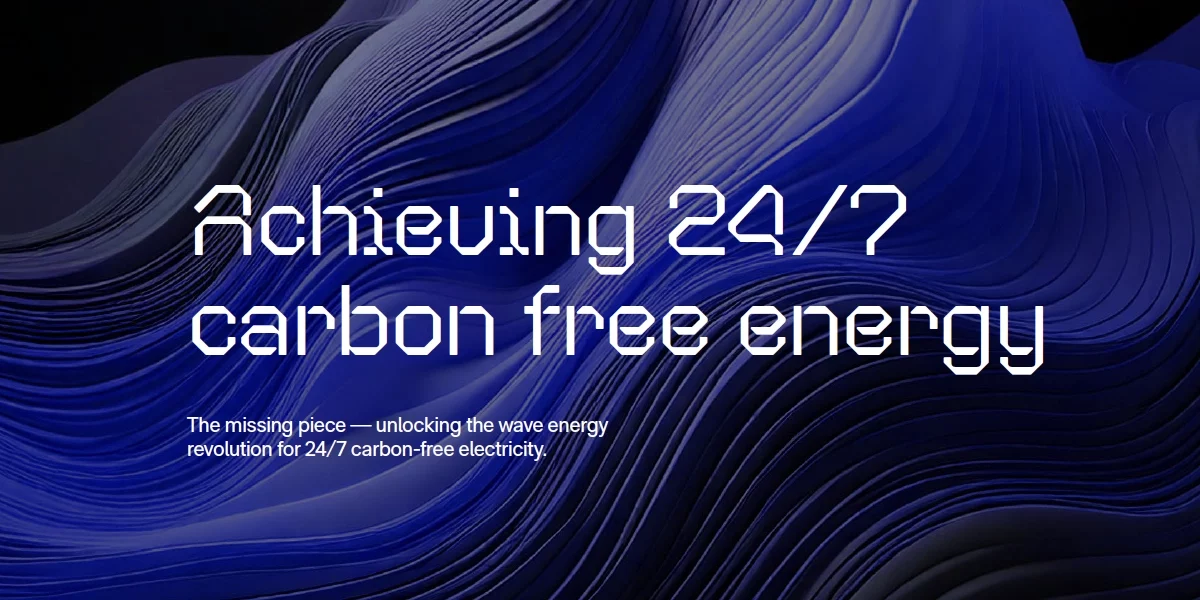The challenge of true carbon-free energy
CorPower Ocean is releasing its first official whitepaper documenting how wave energy offers the missing piece of the puzzle for 24/7 Carbon Free Energy (CFE).
As the world moves toward a sustainable future, sectors such as hydrogen production, heavy industries, and data centres are emerging as critical economic growth and innovation drivers.
These industries, however, share one key characteristic: an unrelenting need for constant 24/7 power to operate effectively. Whether fuelling electrolysis for green hydrogen, powering energy-intensive processes in steel manufacturing, or keeping servers running in data centres, an uninterrupted energy supply is indispensable for ensuring reliability, productivity, and competitiveness.
Why wave energy changes everything
The new whitepaper produced by CorPower Ocean’s leading scientists and engineers explains how despite significant advances in wind and solar power, achieving 24/7 carbon-free energy remains elusive due to their inherent intermittency. And with its continuous generation capability, superior energy density, and complementary production profile, wave energy represents the critical missing piece in the renewable energy puzzle.
The paper sets out how wave energy can stabilise electricity grids, reduce costs, enhance energy security, and create economic opportunity while urging policymakers and investors to act now to avoid repeating the historical mistake of underestimating transformative clean energy technologies.
Key sections are dedicated to the Reality of today’s energy landscape documenting the surge in global energy demand driven by exponential growth of data-intensive applications and technological advancements in artificial intelligence. Up to 61% of the world’s electricity is still sourced from fossil fuels.
The report goes on to tackle The core challenge: Aligning supply and demand as mismatches underscore a fundamental gap in the current renewable energy transition. Meanwhile, the myriad benefits of wave energy – as one of the world’s largest untapped renewable energy sources – are set out in the section The great untapped source at our fingertips. Due to it highly consistent profile adding wave energy to a mix of wind and solar brings us closer to a 24/7 supply. This complementarity remains an overlooked principle in renewable energy investment, which integrates diverse energy sources to stabilise the grid.
The practical implications of wave energy are discussed in the report with references showing how integrating wave energy into existing power grids, industries and cities can lower their energy costs, enhance energy stability and reduce their reliance on fossil fuels.
Essential reading for energy decision-makers
Moving into the economics of wave energy in The investment opportunity of the decade, the paper explains how underestimates of the technology could prove a costly oversight reminiscent of past misjudgements regarding solar energy in 2005 and lithium-ion batteries in 2010. According to McKinsey & Company’s 2024 Wave Energy Market Assessment, the Levelized Cost of Electricity (LCOE) for wave energy could drop below $100/MWh, even with only 300 MW installed in the market, and reach €70/MWh after 600 MW, surpassing the economics of offshore wind.
The paper goes on to state how the integration of wave energy can reduce renewable grid overgeneration by 39%, substantially lowering system costs while providing stable power when other renewable sources are unavailable. This strengthens grid resilience, energy security, and sustainability.
Final sections are dedicated to Why this matters to policy makers as Governments worldwide commit to achieving 24/7 carbon-free energy, but existing policy frameworks still have critical gaps.
A series of policy shift recommendations include:
• Incentives for wave energy investment comparable to those that have enabled wind and solar.
• Incorporation of wave energy explicitly into national energy roadmaps targeting 24/7 carbon-free energy compliance.
• Establishment of market mechanisms that recognise and price predictable renewable sources, ensuring the integration of wave energy into the broader energy mix.
The paper further outlines Next steps for investors with opportunities to explore strategic partnerships, site specific feasibility studies and PPAs that leverage wave energy’s unique reliability by engaging with datacentres and energy intensive industries.
A decade ago, solar power generation was dismissed as economically impractical. Today, it is the world’s cheapest source of electricity. Wave energy stands at a similar tipping point ready to transform the renewable energy landscape.
By downloading these white papers, you’ll gain data-driven perspectives on how wave energy can transform your renewable strategy, reduce costs, and position your organization at the forefront of the sustainable energy revolution.
